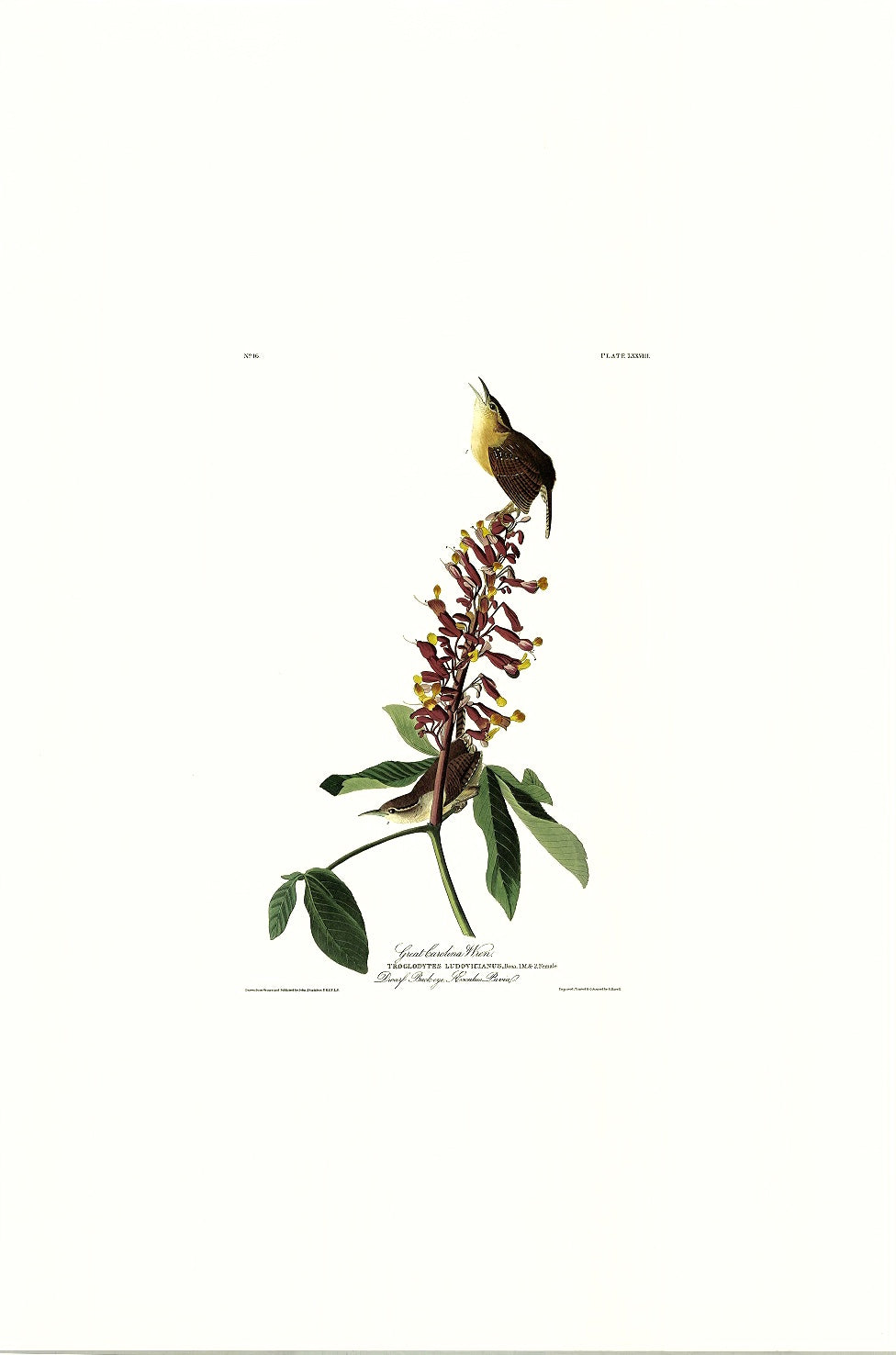Great Carolina Wren
Princeton Audubon Double Elephant Edition
Double elephant (life size - 26 1/4 x 39 1/4) •Limited edition of 1500. •Pencil-numbered and embossed with the Princeton Audubon Limited seal. •Up to 11 color plates used. •Specially developed fade-proof inks. Absolute color fidelity to the actual original. •Printed on a 300 line. •Very heavy archival paper which is recommended by the Library of Congress for archives and is specially toned to match the actual color of the antique originals. •Registered to purchaser. •As permanently displayed at The Royal Society of London, to which Audubon belonged as a Fellow.
Princetons began with the purchase of the actual originals which were physically used in the production process. A giant camera with film the same size as the print took a direct-capture picture of the original, and this exact image was transferred directly to the metal printing plates. There are no other Audubon facsimiles which match the quality of Princeton prints.
Based on a composition painted in Louisiana or Mississippi in 1822. Audubon's young assistant, Joseph Mason, was the artist who painted the blossoming twig which Audubon identified as a "Dwarf horse chestnut."
The Carolina wren seems so full of song-clear, strong, yet sweet. This song consists of loud, rapid triplets, described variously as a spirited three-part tea-kettle, tea-kettle, tea-kettle, or a two-part wheedle, wheedle repeated half a dozen times. Unlike most other wrens, it is nonmigratory. Common in the Southeastern United States, it tends to extend its northern ranges after mild winters. Then, when severe winters return and decimate the ranks, the range limit retracts.
Audubon had his own interpretations of the wren's melodic phrases. In April 1840 when in Richmond, Virginia, he wrote; "The spring is now fairly open, and this day although quite rainy and sad looking I have seen several Hum birds and heard the ever pleasing note of 'Sweet William' from the Carolina Wren..." On another occasion he wrote of the bird: "The little fellow droops its tail and sings with great energy a short ditty somewhat resembling the words come-to-me, come-to-me, repeated several times in quick succession, so loud, and yet so mellow, that it is always agreeable to listen to them."
Princeton Audubon Double Elephant Edition
Double elephant (life size - 26 1/4 x 39 1/4) •Limited edition of 1500. •Pencil-numbered and embossed with the Princeton Audubon Limited seal. •Up to 11 color plates used. •Specially developed fade-proof inks. Absolute color fidelity to the actual original. •Printed on a 300 line. •Very heavy archival paper which is recommended by the Library of Congress for archives and is specially toned to match the actual color of the antique originals. •Registered to purchaser. •As permanently displayed at The Royal Society of London, to which Audubon belonged as a Fellow.
Princetons began with the purchase of the actual originals which were physically used in the production process. A giant camera with film the same size as the print took a direct-capture picture of the original, and this exact image was transferred directly to the metal printing plates. There are no other Audubon facsimiles which match the quality of Princeton prints.
Based on a composition painted in Louisiana or Mississippi in 1822. Audubon's young assistant, Joseph Mason, was the artist who painted the blossoming twig which Audubon identified as a "Dwarf horse chestnut."
The Carolina wren seems so full of song-clear, strong, yet sweet. This song consists of loud, rapid triplets, described variously as a spirited three-part tea-kettle, tea-kettle, tea-kettle, or a two-part wheedle, wheedle repeated half a dozen times. Unlike most other wrens, it is nonmigratory. Common in the Southeastern United States, it tends to extend its northern ranges after mild winters. Then, when severe winters return and decimate the ranks, the range limit retracts.
Audubon had his own interpretations of the wren's melodic phrases. In April 1840 when in Richmond, Virginia, he wrote; "The spring is now fairly open, and this day although quite rainy and sad looking I have seen several Hum birds and heard the ever pleasing note of 'Sweet William' from the Carolina Wren..." On another occasion he wrote of the bird: "The little fellow droops its tail and sings with great energy a short ditty somewhat resembling the words come-to-me, come-to-me, repeated several times in quick succession, so loud, and yet so mellow, that it is always agreeable to listen to them."
